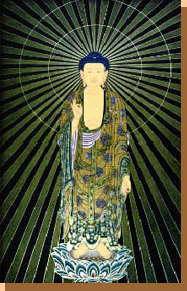Jodo Shinshu or the "True Pure Land School" has its roots in the teachings of Shinran, a 12th century Japanese Tendai monk who left monastic life after 20 years due to the acute awareness of his own limitations.
Shinran applied the same critical eye to institutional Buddhism of the time and concluded that the excluded: women, warriors, fishermen and butchers, the illiterate, the poor, the deeply troubled, and so on, were all particularly well suited for liberation from suffering through the natural working of absolute compassion.
Stripped of his Buddhist rank due to pressure from the religious establishment, Shinran was exiled to a remote area where he married, experienced life outside the capital and its monasteries, and began a long career of study and teaching.
Shinran saw his wife, Eshinni, as a manifestation of the active principle of compassion. Their youngest daughter, Kakushinni, founded the lineage of Jodo Shinshu that has come down to us today.
Basically Shin Buddhists aspire to confidence in the compassionate power of life as it is. Intelligent and resourceful, this reality constantly embraces and accepts us all. We call this Amida Buddha; Amida from the ancient Indian name for "Infinite Life and Infinite Light" and Buddha meaning "Awakened One."
Human beings by nature see things in a limited way. Our effort, our ability, our power to help others and ourselves, are all likewise limited.
Shin Buddhists recognize this reality and shift the focus from self-powered effort to acheive or perfect onto the natural function of Amida: the constant, unobstructed wisdom, compassion and liberative power of life itself that embraces all just as it is.
This natural function is represented by Amida's Vow to apply infinite liberative power to fully enlighten all beings.
Amida's Vow is received and thus fulfilled, over and over, by "Namu Amida Butsu": I take refuge in the awakened One of boundless life and boundless light.
In practice, Shin Buddhists listen to the teachings of Buddha, see the limited quality of their own efforts (in the unobstructed light of Amida's wisdom and compassion), and allow Namu Amida Butsu, remembrance of Amida Buddha or Nembutsu, to inform their lives, just as they are, in this very moment.
Shin Buddhism was brought to Hawaii and North America more than 100 years ago by Japanese immigrants who persevered under the most daunting conditions for decades to root this tradition deep in the American religious landscape. Most of its more than 50 temples were established in the early 1900s, mainly along the western states from Seattle to Los Angeles and in Hawaii, but also in New York, Chicago, the Washington DC area, Phoenix, Denver and several in Canada. The largest US mainland Shin group became the Buddhist Churches of America (BCA), with headquarters in San Francisco and a seminary that is part of the Graduate Theological Union in Berkeley, CA.
The Northampton Shin Buddhist Sangha began around 1991 when Smith College religion professor Taitetsu Unno and his wife Alice, responding to interest from students and others in the Pioneer Valley, began having monthly gatherings in their home for Dharma discussion, Shin practice, and warm Sangha hospitality. Unno Sensei was a Shin minister as well as professor, and Mrs. Unno a gifted and beloved special education teacher in the Northampton public schools. Though each gathering remained relatively small, a vast number and diversity of people passed through the group over the years, attracted no doubt by the plain yet widely resonant expression of the Dharma that the Unnos offerred. The Sangha became more formally organized as time went on and affiliated with the BCA in 2006. In 2007 the Unnos moved to Eugene, OR to be closer to their son Mark, a professor of religion at the University of Oregon (and a Shin minister and, thankfully, a source of Dharma triage for NSBS also). Our group remaining in Northampton is lay-run and works to carry on the simple monthly gathering that began over 20 years ago.
ADDITIONAL RESOURCES:
Taitetsu and Mark Unno Interview

